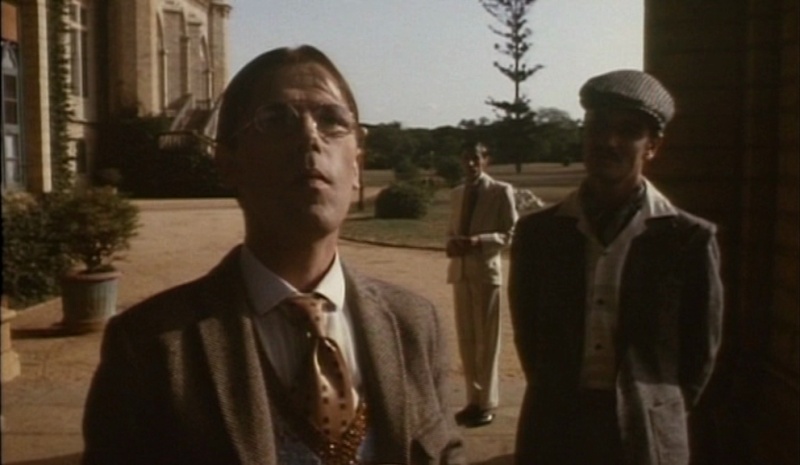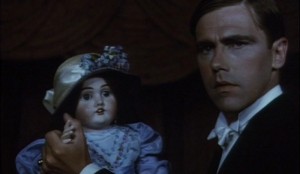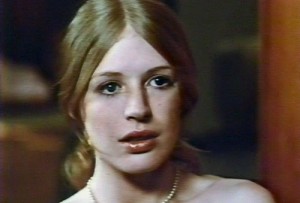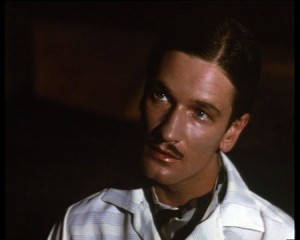From Monthly Film Bulletin, July 1975 (vol. 42, no. 498). –- J.R.
Ghost Story
Great Britain, 1974
Director: Stephen Weeks
England; 1930. Talbot and Duller, former schoolmates of
McFayden, are summoned by the latter to a country house
supposedly belonging to a friend of his father for a weekend
of grouse hunting. Ragged and isolated by the other two for
his callow enthusiasm, Talbot is puzzled to find a warm
teacup and an odd-looking doll in his bedroom. In the
morning, he witnesses a scene in the parlor enacted by
people living forty years ago: Robert Quickworth signing
his sister Sophy over to Dr. Borden’s insane asylum, despite
the protests of her maid. At first Talbot assumes this to be
an elaborate practical joke, but after seeing people who
resemble these characters in the village pub and
dreaming or half-dreaming further episodes — in which
the doll leads him to Borden’s asylum -– he becomes
increasingly obsessed with the intrigue. Meanwhile
Duller, who has come to the house to seek ghosts with
‘scientific’ equipment, is disgruntled when all his
experiments fail and he insists on leaving. McFayden
confesses to Talbot that he has recently inherited the
house and invited him and Duller there to ‘test’ it
for ghosts, mentioning a cousin of his father’s who
went mad there. That night, Talbot sees or dreams
the inmates breaking loose in the asylum and
killing Dr. Borden. McFayden offers to drive Talbot
home, but a rainstorm causes them to postpone the
trip until the next day. On the verge of leaving, Talbot
runs back into the house for his toilet articles and sees
Sophy enter to stab her brother to death while kissing
him, after which the doll strangles Talbot to death.
Unable to find Talbot, McFayden drives away from the
mansion in fright, apparently safe; but in the back seat,
a suitcase snaps open and the doll’s hand emerges . . .
Ultimately adding up to a rather neat and engaging horror tale,
Ghost Story begins somewhat less auspiciously as a slightly
strained genteel comedy of manners. The bumbling good
humor of Talbot colliding with the more snobbish university
sensibilities of Duller and McFayden over such matters as the
preparation of jam sandwiches is groaningly familiar and
overextended drawing-room stuff, made less palatable by the
overplaying of Larry Dann (who gets much better as the film
progresses) and the oily Dracula-like affectations of Murray
Melvin, which comprise an equally illusory red herring about
where the movie seems to be headed. But once the lengthy
‘ghost’ flashbacks get under way and the intrigue divides into
a double-plot — a sort of poor man’s Céline et Julie vont en
bateau without the formal doubling, with Talbot figuring
strangely and effectively as an unseen witness of the various
events — the film gradually arrives at a style and direction of its
own. Very capably shot in a section of India (Ooty, in the Nilgiri
Hills of Tamil Nadu State) that perfectly apes the English
countryside, Ghost Story accumulates a few respectable
tremors once character generally gives way to plot and the skills
of the art director (Peter Young) and cameraman (Peter Hurst)
are permitted to take the foreground, as in the imaginatively lit
night scenes at the asylum. The omnipresent doll bandied about
in the house is an occasionally dubious conceit, as it is seen (1)
pulling back Talbot’s bedcovers, (2) turning into a little girl,
(3) decapitated by Talbot in a moment of rage and (4) strangling
him to death — if only because the special effects delineating all
but (3) are too obvious in their execution — but one is none the
less glad to have it around to provide the grim humor of the
closing twist. Otherwise, a graceful use of period detail and
odd locations (e.g. a cavernous lavatory with three unenclosed
toilets which seems to match the décor in Welles’ The Trial)
help to make Ghost Story a competent foray into supernatural
territory, with lyrical intimations of an irredeemable past of
incest and madness. If only this lyricism were more substantially
linked up with the elaborate machinery that sets the story going,
Stephen Weeks might have wound up with a minor classic on
his hands.
JONATHAN ROSENBAUM




